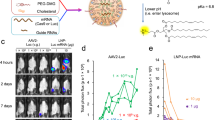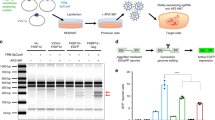Abstract
Intramuscular (i.m.) injection of plasmids followed by electropermeabilization is an efficient process to deliver genes into skeletal myofibers that permits proteins to be produced and secreted at therapeutically relevant levels. To further improve skeletal muscle as a bioreactor, we identified a formulation that elevates transgene expression in myofibers after i.m. injection and electroporation. With secreted placental alkaline phosphate (SEAP) as reporter gene, plasmid formulated with poly-L-glutamate produced two- to eight-fold higher levels of SEAP in mouse serum than plasmid in saline. Various concentrations and molecular weights of poly-L-glutamate were similarly effective, but 6 mg/ml of 15–50 kDa poly-L-glutamate consistently yielded the highest expression levels. The poly-L-glutamate formulation was effective in two different muscle groups in mice at various plasmid doses for several transgenes, including an erythropoietin (EPO) gene, for which expression was elevated four- to 12-fold in comparison to animals that received EPO plasmid in saline. Transgene expression was localized to myofibers. Poly-L-glutamate may improve transgene expression in part by increasing plasmid retention in skeletal muscle. Poly-L-glutamate did not enhance gene transfer in the absence of electroporation. Therefore, the polymer is a novel formulation that specifically enhances the transfer and expression of genes delivered with electroporation.
This is a preview of subscription content, access via your institution
Access options
Subscribe to this journal
Receive 12 print issues and online access
$259.00 per year
only $21.58 per issue
Buy this article
- Purchase on Springer Link
- Instant access to full article PDF
Prices may be subject to local taxes which are calculated during checkout






Similar content being viewed by others
References
MacColl GS, Goldspink G, Bouloux PM . Using skeletal muscle as an artificial endocrine tissue J Endocrinol 1999 162: 1–9
Wolff JA et al. Direct gene transfer into mouse muscle in vivo Science 1990 247: 1465–1468
Manthorpe M et al. Gene therapy by intramuscular injection of plasmid DNA: studies on firefly luciferase gene expression in mice Hum Gene Ther 1993 4: 419–431
Danko I et al. High expression of naked plasmid DNA in muscles of young rodents Hum Mol Genet 1997 6: 1435–1443
Zhang G et al. Efficient expression of naked DNA delivered intra-arterially to limb muscles of nonhuman primates Hum Gene Ther 2001 12: 427–438
Mir LM et al. High-efficiency gene transfer into skeletal muscle mediated by electric pulses Proc Natl Acad Sci USA 1999 96: 4262–4267
Mumper RJ et al. Protective interactive noncondensing (PINC) polymers for enhanced plasmid distribution and expression in rat skeletal muscle J Controlled Release 1998 52: 191–203
Lemieux P et al. A combination of poloxamers increases gene expression of plasmid DNA in skeletal muscle Gene Ther 2000 7: 986–991
Rols MP et al. In vivo electrically mediated protein and gene transfer in murine melanoma Nature Biotechnol 1998 16: 168–171
Yoshizato K et al. Gene delivery with optimized electroporation parameters shows potential for treatment of gliomas Int J Oncol 2000 16: 899–905
Goto T et al. Highly efficient electro-gene therapy of solid tumor by using an expression plasmid for the herpes simplex virus thymidine kinase gene Proc Natl Acad Sci USA 2000 97: 354–359
Heller L et al. Electrically mediated plasmid DNA delivery to hepatocellular carcinomas in vivo Gene Ther 2000 7: 826–829
Titomirov AV, Sukharev S, Kistanova E . In vivo electroporation and stable transformation of skin cells of newborn mice by plasmid DNA Biochim Biophys Acta 1991 1088: 131–134
Banga AK, Prausnitz MR . Assessing the potential of skin electroporation for the delivery of protein- and gene-based drugs Trends Biotechnol 1998 16: 408–412
Heller R et al. In vivo gene electroinjection and expression in rat liver FEBS Lett 1996 389: 225–228
Suzuki T et al. Direct gene transfer into rat liver cells by in vivo electroporation FEBS Lett 1998 425: 436–440
Aihara H, Miyazaki J . Gene transfer into muscle by electroporation in vivo Nature Biotechnol 1998 16: 867–870
Mathiesen I . Electropermeabilization of skeletal muscle enhances gene transfer in vivo Gene Ther 1999 6: 508–514
Vicat JM et al. Muscle transfection by electroporation with high-voltage and short-pulse currents provides high-level and long-lasting gene expression Hum Gene Ther 2000 11: 909–916
Kriess P et al. Erythropoietin secretion and physiological effect in mouse after intramuscular plasmid DNA electrotransfer J Gene Med 1999 1: 245–250
Rizzuto G et al. Efficient and regulated erythropoietin production by naked DNA injection and muscle electroporation Proc Natl Acad Sci USA 1999 96: 6417–6422
Maruyama H et al. Continuous erythropoietin delivery by muscle-targeted gene transfer using in vivo electroporation Hum Gene Ther 2000 11: 429–437
Bettan M et al. High-level protein secretion into blood circulation after electric pulse-mediated gene transfer into skeletal muscle Mol Ther 2000 2: 204–210
Fewell JG et al. Gene therapy for the treatment of hemophilia B using PINC-formulated plasmid delivered to muscle with electroporation Mol Ther 2001 3: 574–583
Krieg AM . Direct Immunologic activities of CpG DNA and implications for gene therapy J Gene Med 1999 1: 56–63
Barry ME et al. Role of endogenous endonucleases and tissue site in transfection and CpG-mediated immune activation after naked DNA injection Hum Gene Ther 1999 10: 2461–2480
Mahato RI et al. Biodistribution and gene expression of lipid/plasmid complexes after systemic administration Hum Gene Ther 1998 9: 2083–2099
Mumper RJ et al. Polyvinyl derivatives as novel interactive polymers for controlled gene delivery to muscle Pharm Res 1996 13: 701–709
Levy MY et al. Mechanism of gene uptake and expression in adult mouse skeletal muscle Pharm Res 1994 11: 317
Neumann E, Kakorin S, Toensing K . Fundamentals of electroporative delivery of drugs and genes Bioelectrochem Bioenerg 1999 48: 3–16
Sukharev SI et al. Electroporation and electrophoretic DNA transfer into cells. The effect of DNA interaction with electropores Biophys J 1992 63: 1320–1327
Wolf H et al. Control by pulse parameters of electric field-mediated gene transfer in mammalian cells Biophys J 1994 66: 524–531
Fujii T et al. Inhibition of microtubule assembly by poly(L-glutamic acid) and the site of its action Biochem Cell Biol 1986 64: 615–621
Matteoni R, Kreis TE . Translocation and clustering of endosomes and lysosomes depends on microtubules J Cell Biol 1987 105: 1253–1265
Courvalin JC, Domontier M, Bornens M . Solubilization of nuclear structures by the polyanion heparin J Biol Chem 1982 257: 456–463
Stein A, Mitchell M . Generation of different nucleosome spacing periodicities in vitro. Possible origin of cell type specificity J Mol Biol 1998 203: 1029–1043
Moran RG . Roles of Folylpoly-γ-glutamate synthetase in therapeutics with tetrahydrofolate antimetabolites: an overview Semin Oncol 1999 26: 4–32
Wilcheck M, Frensdorff A, Sela M . New synthesis of poly-L-glutamic acid and poly-L-glutamyl proteins Arch Biochem Biophys 1966 113: 742–749
Li C et al. Complete regression of well-established tumors using a novel water-soluble poly(L-glutamic acid)-paclitaxel conjugate Cancer Res 1998 58: 2404–2409
Li C et al. Antitumor activity of poly(L-glutamic acid)-paclitaxel on syneneic and xenografted tumors Clin Cancer Res 1999 5: 891–897
Singer JW et al. Water-soluble poly-(L-glutamic acid)-Gly-camptothecin conjugates enhance camptothecin stability and efficacy in vivo J Controlled Release 2001 74: 243–247
Otani Y, Tabata Y, Ikada Y . Rapidly curable biological glue composed of gelatin and poly(L-glutamic acid) Biomaterials 1996 17: 1367–1391
Otani Y, Tabata Y, Ikada Y . Hemostatic capability of rapidly curable glues from gelatin, poly(L-glutamic acid), and carbodiimide Biomaterials 1998 19: 2091–2098
Maurer PH . Antigenicity of polypeptides (poly-α-amino acids) J Immunol 1965 95: 1095–1099
Abruzzese RV et al. Ligand-dependent regulation of plasmid-based transgene expression in vivo Hum Gene Ther 1999 10: 1499–1507
Acknowledgements
The authors would like to thank Margaret Gondo, Vidya Mehta, Debra Bruce, Ingrid Anscombe, Valarie Florack and Jason Fewell for technical assistance and useful comments.
Author information
Authors and Affiliations
Rights and permissions
About this article
Cite this article
Nicol, F., Wong, M., MacLaughlin, F. et al. Poly-L-glutamate, an anionic polymer, enhances transgene expression for plasmids delivered by intramuscular injection with in vivo electroporation. Gene Ther 9, 1351–1358 (2002). https://doi.org/10.1038/sj.gt.3301806
Received:
Accepted:
Published:
Issue Date:
DOI: https://doi.org/10.1038/sj.gt.3301806
Keywords
This article is cited by
-
Optimization of piggyBac Transposon System Electrotransfection in Sheep Fibroblasts
Molecular Biotechnology (2023)
-
Systematic optimization of square-wave electroporation conditions for bovine primary fibroblasts
BMC Molecular and Cell Biology (2020)
-
Short noncoding DNA fragments improve the immune potency of electroporation-mediated HBV DNA vaccination
Gene Therapy (2014)
-
Biodegradable poly(amine-co-ester) terpolymers for targeted gene delivery
Nature Materials (2012)
-
Gene Transfer: How Can the Biological Barriers Be Overcome?
The Journal of Membrane Biology (2010)



